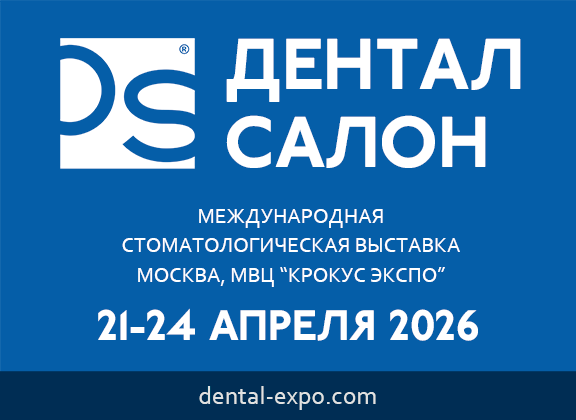DOI:
10.37988/1811-153X_2024_2_157Objectification of remineralization therapy results using the quantitative light-induced fluorescence (QLF) method
Downloads
Abstract
Objectification of the assessment of the dynamic status of enamel demineralization during remineralization therapy is an urgent task in many clinical situations. This article presents a modern quantitative light-induced fluorescence (QLF) technique for the digital assessment of enamel remineralization processes. Clinical cases with the QLF technique in patients undergoing a course of remineralization therapy are presented. Indicators of enamel mineralization in the area of the studied teeth according to QLF after a 14-day course of remineralizing therapy R.O.C.S. Medical minerals were: ∆F average loss of mineral components of enamel — from 18.0 to 6.8%, maximum loss of mineral components (∆Fmax) — from 32.1 to 8.8%,lesion volume (∆Q) — from 2988 to 47, area area of loss of mineral components — from 166 to 7 px, area with bacterial activity (∆R) — from 32 to 23%, maximum bacterial activity (∆Rmax) — from 65 to 0%, area of bacterial activity — from 413 to 72px, the area of the white spot with bacterial activity, showed positive dynamics and a result of 19—100% in different teeth.Conclusion.
Thus, all selected values from the QLF study showed positive dynamics after a course of remineralizing therapy.
Key words:
enamel demineralization, remineralization therapy, quantitative light-induced fluorescenceFor Citation
[1]
Akulovich A.V., Nikiforova G.G., Korostelev A.A., Yalyshev R.K., Matelo S.K. Objectification of remineralization therapy results using the quantitative light-induced fluorescence (QLF) method. Clinical Dentistry (Russia). 2024; 27 (2): 157—164. DOI: 10.37988/1811-153X_2024_2_157
References
- Mehta R., Nandlal B., Prashanth S. Comparative evaluation of remineralization potential of casein phosphopeptide-amorphous calcium phosphate and casein phosphopeptide-amorphous calcium phosphate fluoride on artificial enamel white spot lesion: an in vitro light fluorescence study. Indian J Dent Res. 2013; 24 (6): 681—9. PMID: 24552927
- Sysoeva O.V., Bondarenko O.V., Tokmakova S.I., Dudareva E.G.T. Effectiveness assessment tools for the remineralization therapy. Actual Problems in Dentistry. 2013; 3: 32—35 (In Russian). eLIBRARY ID: 19394879
- Kouzmina E., Benya V. Remineralizing efficacy of toothpaste containing hydroxyapatite. Dental Forum. 2012; 4: 6—9 (In Russian). eLIBRARY ID: 17795061
- Bulkina N.V., Pudovkina E.A., Akulovich A.V., Zakharevich A.M. Dentin surface morphology changes after applying pastes with calcium hydroxyapatite or nanohydroxyapatite. Stomatology. 2014; 1: 11—15 (In Russian). eLIBRARY ID: 21218152
- Solovyeva Zh.V. A study of the prevention and non-invasive methods of enamel caries treatment: master’s thesis abstract. Krasnodar, 2019. 26 p. (In Russian).
- Magsumova O.A., Postnikov M.A., Trunin D.A., Bagdasarova O.A., Simanovskaya O.E., Korchagina M.S., Dudina S.E., Romanova T.V., Polkanova V.A. Remineralizing therapy as a non-invasive method of treating focal demineralization of enamel. Clinical Dentistry (Russia). 2021; 4: 6—12 (In Russian). eLIBRARY ID: 47475733
- Dhanya K., Chandra P., Anandakrishna L., Karuveettil V. A comparison of NovaMin and casein phosphopeptide amorphous calcium phosphate fluoride on enamel remineralization An in vitro study using scanning electron microscope and DIAGNOdent. Contemp Clin Dent. 2021; 12 (3): 301—307. PMID: 34759689
- Matelo S.K., Kupets T.V., Zhardetskiy A.I., Polyanskaya L.N. Medical efficacy of childrens calcium-phosphate toothpastes and toothpastes with low fluoride concentration: results of two-year program of controlled teeth cleaning. Current Pediatrics (Moscow). 2011; 2: 86—90 (In Russian). eLIBRARY ID: 16458649
- Gegamyan A.O., Sarap L.R., Zeibert A.Yu. Evaluation of enamel remineralization rate by quantitative light-induced fluorescence. Clinical Dentistry (Russia). 2021; 4: 13—17 (In Russian). eLIBRARY ID: 47475735
- Akulovich A.V., Nikiforova G.G., Korostelev A.A., Matelo S.K. Quantitative light-induced fluorescence (QLF) for diagnosis of enamel condition during various dental procedures. Parodontologiya. 2023; 1: 55—65 (In Russian). eLIBRARY ID: 50451535
- Lytkina A.A., Zeybert A.Yu. Early diagnosis of fissure caries in children using the qlf method. Scientist (Russia). 2022; 2 (20): 37—40 (In Russian). eLIBRARY ID: 48317534
- Gomez J. Detection and diagnosis of the early caries lesion. BMC Oral Health. 2015; 15 Suppl 1 (Suppl 1): S3. PMID: 26392124
- Makarova N.E. Improvement of methods of diagnostics and treatment of focal demineralization of tooth enamel: master›s thesis abstract. Moscow, 2018. 24 p. (In Russian).
- Ko H.Y., Kang S.M., Kim H.E., Kwon H.K., Kim B.I. Validation of quantitative light-induced fluorescence-digital (QLF-D) for the detection of approximal caries in vitro. J Dent. 2015; 43 (5): 568—75. PMID: 25724115
- Kreher D., Park K.J., Schmalz G., Schulz-Kornas E., Haak R., Ziebolz D. Evaluation of quantitative light-induced fluorescence to assess lesion depth in cavitated and non-cavitated root caries lesions An in vitro study. Photodiagnosis Photodyn Ther. 2022; 37: 102675. PMID: 34906738
- Kirillova E.V. Improvement of methods of treatment and prevention of dental caries in young children: master›s thesis abstract. Moscow, 2013. 24 p. (In Russian).
- Gegamyan A., Lytkina A., Sarap L., Zeybert A. Quantitative light induced fluorescence method in comparative assessment of enamel remineralization indicatiors in vivo and during remineralizing therapy. Sovremennaya stomatologiya (Belarus). 2021; 4 (85): 70—74 (In Russian). eLIBRARY ID: 47832575
- Park S.W., Kang S.M., Lee H.S., Kim S.K., Lee E.S., Kim B.R., de Josselin de Jong E., Kim B.I. Lesion activity assessment of early caries using dye-enhanced quantitative light-induced fluorescence. Sci Rep. 2022; 12 (1): 11848. PMID: 35831391
- Shimpo Y., Nomura Y., Sekiya T., Arai C., Okada A., Sogabe K., Hanada N., Tomonari H. Effects of the dental caries preventive procedure on the white spot lesions during orthodontic treatment An open label randomized controlled trial. J Clin Med. 2022; 11 (3): 854. PMID: 35160305
- Guerrieri A., Gaucher C., Bonte E., Lasfargues J.J. Minimal intervention dentistry: Part 4. Detection and diagnosis of initial caries lesions. Br Dent J. 2012; 213 (11): 551—7. PMID: 23222326
Downloads
Received
March 18, 2024
Accepted
May 20, 2024
Published on
June 28, 2024










